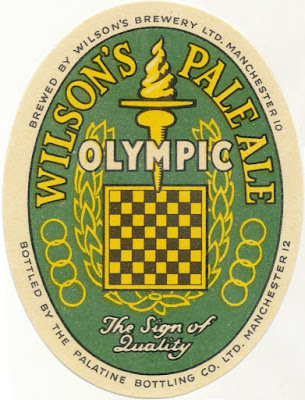But, you might say, CAMRA had started publishing gravities in the Good Beer Guide. However, that was all they published. They didn't include the ABV or the price. Information which the Mirror did provide. Using the ABV, I've been able to calculate the FG and the degree of attenuation. The type of stuff I lap up. CAMRA also only concerned themselves with cask beer. So there was nothing about the strength of keg beer.
The first article I'm consulting has 81 analyses. Mostly draught Bitter, but, for some reason, also including Old Peculier. They come from all over the UK. I thought it would be more manageable to split them up by region.
I'm starting with the Northeast, which I've defined as everything East of the Pennines from South Yorkshire to the Scottish border. It's pretty arbitrary, but what the hell.
If you're wondering why the prices are missing for some beers you can blame the newspaper archive. The right-hand edge of one of the pages has been clipped, cutting off the prices.
I almost forgot another handy thing about the Mirror articles. They include some rudimentary tasting notes. Something that wasn't very common in the 1970s. Oh, and there's also a score out of 12. So you can see which beers the two journalists who compiled the report liked best. All useful stuff.
It's interesting how high the rate of attenuation is. It averages a whisker short of 80%.
The average gravity of 1037.3º is about exactly the same as average UK beer gravity overall. The spread of gravities is quite small, from 1032º to 1042º, but with most between 1036º and 1038º.
I've excluded Old Peculier from averages because, well, it isn't a Bitter.
| Northeastern Bitters in 1978 | ||||||||||
| Brewer | Beer | Price per pint (p) | º gravity per p | % ABV per p | OG | FG | ABV | App. Atten-uation | score | Flavour |
| Theakston | Old Peculier | 1056.2 | 1014.8 | 5.38 | 73.67% | 11 | Rich, fine & deceptively mellow. | |||
| Timithy Taylor | Landlord Bitter | 1042 | 1008 | 4.42 | 80.95% | 10 | Full bodied, hoppy taste. | |||
| Cameron | Strongarm | 1041.2 | 1011.7 | 3.82 | 71.60% | 10 | Rich flavoured brew. Great value. | |||
| Federation | Federation Special | 1040.9 | 1009.5 | 4.08 | 76.77% | 11 | A member ot Beer’s yalty. Excellent. | |||
| Newcastle | Newcastle Exhibition | 1040 | 1007 | 4.29 | 82.50% | 10 | Crisp, nutty flavour, Very good. | |||
| Stones | Best Bitter | 29 | 1.33 | 0.14 | 1038.6 | 1007.1 | 4.10 | 81.61% | 8 | Fruity & nicely balanced. |
| Timithy Taylor | Best Bitter | 32 | 1.19 | 0.14 | 1038.2 | 1004.8 | 4.35 | 87.43% | 8 | Real “Bitter”. Unusual flavour. |
| Ward | Sheffield Best Bitter | 28 | 1.35 | 0.14 | 1037.9 | 1006.8 | 4.05 | 82.06% | 10 | A beautiful nutty bitter. |
| Vaux | Sunderland Best Bitter | 29 | 1.29 | 0.13 | 1037.3 | 1008.95 | 3.68 | 76.01% | 8 | Nice, smooth and hoppy. |
| Webster | Pennine Bitter | 31 | 1.19 | 0.13 | 1036.8 | 1006.65 | 3.92 | 81.93% | 10 | An excellent beer needing an acquired taste. |
| Hull | Old Traditional Bitter | 31 | 1.17 | 0.12 | 1036.2 | 1007.55 | 3.72 | 79.14% | 9 | Creamy, nicely hepped bitter. |
| Tetley | Cask Bitter | 29 | 1.25 | 0.13 | 1036.2 | 1006.3 | 3.89 | 82.60% | 11 | Real ale. Truly supurb. |
| Tetley | Keg Bitter | 31 | 1.16 | 0.12 | 1036.1 | 1006.95 | 3.79 | 80.75% | 8 | Last survey champion, but not quite my palate. |
| John Smith | Best Bitter | 33 | 1.09 | 0.11 | 1036 | 1007.3 | 3.73 | 79.72% | 8 | Creamy, tasty. Good flavour. |
| Cameron | Best Bitter | 27 | 1.31 | 0.13 | 1035.3 | 1008.7 | 3.45 | 75.35% | 9 | Nice fruity taste. Good head and lively. |
| Federation | Federation Ordinary | 23 | 1.40 | 0.14 | 1032.1 | 1007.35 | 3.21 | 77.10% | 9 | Refreshing. Lacks guts but no complaints at the price. |
| Newcastle | Newcastle Amber | 26 | 1.23 | 0.13 | 1032.1 | 1005.4 | 3.47 | 83.18% | 6 | Party beer. Nice hut you can’t come to any harm. |
| Average | 29.1 | 1.25 | 0.13 | 1037.3 | 1007.5 | 3.87 | 79.92% | 9.1 | ||
| Source: | ||||||||||
| Sunday Mirror - Sunday 17 September 1978, pages 22 - 23. | ||||||||||



















































































